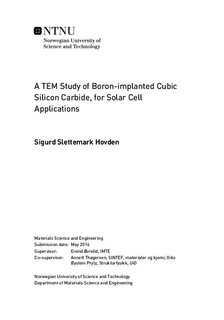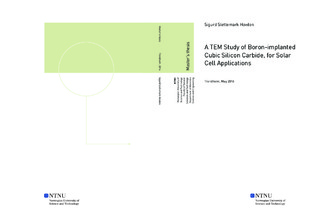| dc.description.abstract | Recent research suggests that high doses of boron implantation can introduce an intermediate electron energy band in cubic silicon carbide (3C-SiC). This makes it a viable material for a highly efficient intermediate band solar cell. Implantation techniques do often introduce material defects which are unwanted in solar cells, as they generally act to increase charge carrier recombination, lowering the solar cell efficiency. Transmission electron microscopy has in this thesis been utilised to investigate the structural effects of boron implantation and subsequent annealing, which was found necessary for post-implantation recrystallisation. It was found that as-grown 3C-SiC from the University of Linköping is almost defect-free, disregarding macro scale domain phase boundaries. Boron implantation of 2-3 at% at 400°C was found to amorphise the 3C-SiC, and subsequent annealing at 1400°C for one hour was found to give complete recrystallisation. The boron implanted 3C-SiC does regain single crystallinity from the annealing procedure, but with a significant increase in stacking faults, as well as the formation of boron-rich precipitate phases. Electron diffraction data suggests some degree of boron substitution of silicon in the 3C-SiC lattice. An attempt to further investigate the nature of the boron distribution was performed using electron energy loss spectroscopy simulations and experiments, but was not successful. A method for simulating such spectra for 3C-SiC was however developed, and was found to give reliable results. The work performed in this thesis suggests that the boron implantation dose should be lowered to avoid precipitates and possibly also to avoid the formation of stacking faults. It is also suggested that the implantation temperature should be increased. This could possibly counteract amorphisation, removing the need for post-implantation annealing, and thus also avoid the formation of boron rich precipitates without lowering the boron implantation dose. | |

